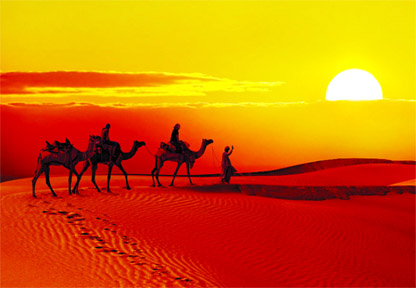Jaisalmer, a mesmerizing destination nestled in the heart of the Thar Desert, is a jewel in the crown of Rajasthan. Often referred to as the “Golden City,” Jaisalmer captivates visitors with its sandstone architecture, picturesque landscapes, and rich cultural heritage. The city is adorned with lakes, ornate Jain temples and havelis.
One of the standout attractions in Jaisalmer is the magnificent Jaisalmer Fort, a UNESCO World Heritage Site and one of the largest fully preserved fortified cities in the world. Constructed using golden-yellow sandstone, the fort seems to blend seamlessly with the surrounding desert, earning it the moniker “Sonar Quila” or the Golden Fort. Inside, visitors can explore narrow winding lanes, intricately carved havelis, and the imposing Maharaja’s Palace.
The havelis of Jaisalmer, such as Patwon Ki Haveli and Salim Singh Ki Haveli, showcase the city’s opulent architectural heritage. These grand mansions boast exquisite carvings, delicate balconies, and intricate facades, providing a glimpse into the affluent lifestyle of the merchants who once inhabited them. The Gadisar Lake, a historic water reservoir surrounded by temples and ghats, adds a tranquil touch to the vibrant city. The Jain Temples within the fort premises showcase stunning architecture and intricate marble work. A camel safari in the vast expanses of the Thar Desert is an essential Jaisalmer experience. The golden dunes, changing hues during sunrise and sunset, create a magical setting for an unforgettable adventure. Camping under the star-studded desert sky adds to the allure of the desert safari. Jaisalmer, like other cities in Rajasthan, celebrates its cultural vibrancy through festivals like the Desert Festival. This three-day extravaganza showcases the rich folk culture of Rajasthan, featuring traditional music, dance, camel races, and vibrant processions.
Desert National Park
Most national parks in India boast of dense forests and large water bodies, this one is an exception. Although one may not see a tiger or rhino, spotting wildlife that calls the desert their home is a thrill in itself. Keep your eyes out for hares, foxes, the blackbuck, the endangered Great Indian Bustard, Russell’s viper and several migratory birds in the winter months.
Jaisalmer Fort
What sets it apart is that unlike most forts in Rajasthan, locals inhabit this one. One can shop, eat and sightsee while strolling through it. What is unusual to see though is the large number of ‘Free Tibet‘ banners that dot shops.
Longewala
JP Dutta’s Border (1997) was a hit at the box office. And while most believe it is a work of fiction, a visit to Longewala – on the road to Tanot – will prove otherwise. Border Security Force (BSF) officers stationed here show you the well that was poisoned by Pakistanis in the 1971 war, an enemy tank and crane still there and a memorial to those who sacrificed their lives for the country.
Border
The Indo-Pak border lies less than 20 km from Tanot. Though not as famous as the Wagah Border, one can see the last Indian pillar and the Pakistani outpost from here. Visitors, however, are not allowed after sunset. One also needs prior approvals from the BSF to go there. Interestingly, Jaisalmer’s proximity to Pakistan is also visible in the local markets with paan masala from across the border sold openly in shops.
Bada Bagh
Other points of interest you could also head to are Patwaon-Ki-Haveli, Thar Heritage Museum, Maharaja’s Palace, Gadisar Lake (with boating) and Vyas Chhatri.
Kuldhara
Rajasthan may be famous for India’s most haunted spot, Bhangarh, but you could get a dose of the eerie in Jaisalmer too. According to legend, an entire community vanished overnight 200 years ago at a place close to Jaisalmer. Though there are several tales on the reason behind their sudden disappearance, today all that remains – as proof of their existence – is the abandoned village of Kuldhara. What’s more, according to locals, the villagers left behind a curse bringing death to anyone who tried to inhabit it.
Tanot Mata’s Temple
This serene spot lies about 120 km from Jaisalmer. It is the last village before the Indo-Pak border. What makes it unique is that the BSF maintains it. They took over the day-to-day functioning after bombs dropped by Pakistan in the vicinity of the temple in the 1965 did not explode. In fact, they now lie on display within the temple premises.
Jaisalmer: The Golden City
